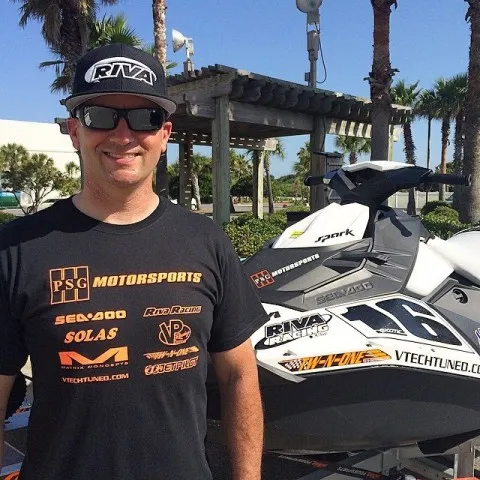Fresh from a stellar weekend of racing in the CWA racing in Michigan, we caught up with RIVA Racing Team Rider Paul Green, who has been successfully campaigning a 2015 Sea-Doo Spark in the Rec Lites class. Paul offered some insight on why he chose to race the Spark for 2015, and what advantages the new craft offers:
The Watercraft Journal: How does a stock Spark handle compared to other traditional larger runabouts? What did you need to learn to ride it successfully?
Paul Green: The Sea-Doo Spark has a major power-to-weight advantage over any other Runabout on the market. At just over 400 pounds, the craft benefits from a light feel on the water with enough power to bring a smile to even the most seasoned rider. The first thing you notice when you spend a day with the Spark is that one person can move the boat around both on the shore and in the water with little effort. Once you sit on the craft in the water, it gives you a sense that you’ll be riding and controlling the craft and not the other way around like many of the larger platforms.
WCJ: What does the stock hull like to do in chop or while racing? What does it do well? What not-so-well
PG: One of the major advantages to the platform is the ability to choose the two or three person hull option. As many of you know, the three-seater version mainly consists of a bolt-on rear hull extension that lengthens the hull. The two versions of the hull handle very differently. In calm conditions, the two up version seems to benefit from a slightly higher mph over the three up. This fact changes however once the conditions rough up and you’re faced with chop on the race start or during the race.
The two-up hull tends to pop the front end up on a race start if you’re not standing over top of the handlebars. The three-up version is more planted on the start since the rear hull extension does not allow the back of the hull to sink down and raise the nose of the boat under hard acceleration. The adjustability of the base hull from a two-up to a three-up makes the package unique.
WCJ: What do you do to get it to handle better? (body positioning, foot/knee placement, weight shifting)
PG: I usually tell anyone who plans on racing a Spark to purchase the three up version first in order to get the hull extension from the factory. They can simply remove the hull extension should they crave the livelier feel of the two up ride.
Personally, I ride a three-up hull as I feel the steady handling it provides on the course out-weigh the slight mph advantage the two up may provide in perfect conditions. The riding position on both the two up and three up encourages a forward riding style. The closer you are to the front of the seat, the better control you’ll have.
WCJ: What modifications/aftermarket parts do you use? How do they improve the Spark’s handling?
PG: I use the RIVA Racing Intake Grate, Solas impeller and RIVA Racing Stainless Steel pump liner. The combination of those three parts along with the RIVA Racing Pro Series sponsons takes the craft to a higher level of performance and handling. A RIVA Racing Seat cover also helps since the stock-seating surface can get a little slippery when you’re pushing hard under race conditions.
My race Spark has a reflashed ECU from VTECH which increasing timing, raises the RPM limit, and provides fuel mapping that makes the craft accelerate harder and reach greater top speed. The mapping I use is a one off file that I have designed along with VTECH to utilize the benefits of VP Race Fuel.
WCJ: What has been a major hurdle you’ve had to overcome while racing a Spark?
PG: One of the problems with the design of the Spark is that it suffers from limited fresh air intake to the motor area of the hull. The fresh air that comes in from the front of the hull meets obstruction from the gas tank and the flotation foam before it passes into the engine area. The hull is not equipped with any venting to allow hot air and gases to escape the engine area. This creates a problem for the tuner since the engine heat soaks under racing load.
The stock ECU recognizes the increase in temperature and immediately starts to take timing and performance out of the engine to protect it from overheating and damage. Running a Florite-style air vent in the oil inspection hole on the right side of the hull will help pull hot air from the hull. RIVA sells the round vents that are inexpensive and snap into the stock hole in seconds. Engineers at RIVA Racing are currently working on a solution to address the issue of fresh air supply to the engine.
We will be testing a new product from RIVA Racing shortly in that regard. Also running a high quality race fuel with higher-octane values will insure the stock antiknock sensor does not override the engine management and again remove performance from the engine.
WCJ: Why is the Spark a good platform to race on? Why did you choose to race a Spark this year?
PG: I like the Spark for racing since it’s affordable to purchase, hull can take a bump and not break like traditional fiberglass, parts are affordable, speeds for racing are safe for newcomers to the sport (under 55 mph), the engine is trouble free with fuel injection and a clean burning 4-stroke that is the most fuel efficient engine I’ve ever seen in a PWC.
WCJ: Where do you see the future of Sea-Doo Spark racing?
PG: [As I see it,] the future of the Spark in racing will depend on three things: 1. Sea-Doo’s commitment to promoting the craft as an option for racing (ie. higher contingency payouts for podium finishes and better support for the class). 2. Promoters recognizing this as a craft that will potentially bring new racers to the sport of runabout racing due to the reasonable cost to purchase and safer racing speeds. 3. A second manufacturer building a craft that will compete directly with the Spark in the Rec Lites category.
“RIVA Racing Team Rider Spotlight – Paul Green” was first published on RIVAracing.com on July 15, 2015 HERE.













